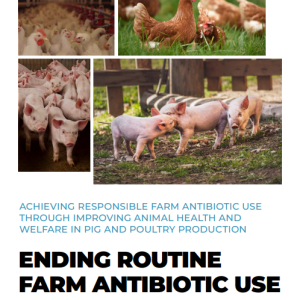
This report, prepared for the European Public Health Alliance by Cóilín Nunan of the Alliance to Save Our Antibiotics, argues that changing animal husbandry practices to improve animal welfare is essential for reducing the routine use of antibiotics on farms.
The European Union has banned routine farm antibiotic use as of 28 January 2022. The report sees this as a positive step which could, if properly implemented, help tackle antibiotic resistance and protect animal and human health. However, it raises concerns that the legislation may not be fully complied with, particularly in intensive livestock systems that often rely on antibiotics to compensate for poor hygiene and high levels of disease.
The report makes ten recommendations:
- Keep antibiotic use on farms to below 30 mg per kg of population correction unit, and ultimately cut this to below 15 mg/kg.
- Use antibiotics mainly to treat individual sick animals, specifically by limiting group treatments to 30% of all farm antibiotics treatments, and ultimately to less than 15%.
- Collect data on antibiotic use by species and by farming system (intensive, free range, etc.).
- Ban the use of the antibiotic colistin in livestock, to keep it as a last-resort for treating life-threatening infections in humans. Limit fluoroquinolone and cephalosporin to the option of last resort for treating individual sick animals, and never use them in group antibiotic treatments.
- Raise the minimum weaning age of piglets from 21 to 35 days, as studies show this results in lower antibiotic use.
- Raise the minimum slaughter age for broilers to 56 days, from 32, since using slower-growing breeds can reduce antibiotic requirements. Use more resilient and healthy breeds in all farm species.
- Reduce indoor stocking densities to improve hygiene, and provide enrichment materials such as straw bedding, to reduce stress.
- Provide outdoor access for livestock, since studies suggest this reduces disease and antibiotic use (but appropriate breeds must be used to permit outdoor farming).
- Include sufficient fibre in diets, to promote good gut health and reduce disease incidence.
- Ban tail docking of piglets, since it can cause long-term pain and infections. Reduce the risks of tail-biting (the reason for docking tails) by keeping pigs at lower stocking densities and providing bedding materials.
Read the full report, Ending routine farm antibiotic use in Europe: Achieving responsible farm antibiotic use through improving animal health and welfare in pig and poultry production, here or here (PDF link). See also the TABLE explainer What is the connection between infectious diseases in humans and livestock?







Post a new comment »